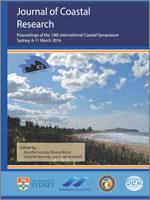Reinke, J.; Lemckert, C., and Meynecke, J.-O., 2016. Coastal fronts utilised by migrating humpback whales, Megaptera novaeangliae, on the Gold Coast, Australia. In: Vila-Concejo, A.; Bruce, E.; Kennedy, D.M., and McCarroll, R.J. (eds.), Proceedings of the 14th International Coastal Symposium (Sydney, Australia). Journal of Coastal Research, Special Issue, No. 75, pp. 552–556. Coconut Creek (Florida), ISSN 0749-0208.
Large-scale migration patterns of humpback whales, Megaptera novaeangliae, are quite well known; however, small-scale distribution patterns and relationships with environmental conditions have received less attention. Protection from a range of threats, as well as predicting the effects of climate change, requires knowledge of preferred habitat and environmental conditions. East Australian humpback whales travel from the Southern Ocean towards the Great Barrier Reef to breed. The East Australian coastal environment is dominated by the East Australian Current that carries warm water poleward from the tropics and generates upwelling conditions on the coast. Sharp temperature changes develop at the border of the warm current and the cooler coastal and upwelled waters. This study outlines methodologies and proposes relationships between humpback whale distribution and sea surface temperature (and temperature gradient) on the Gold Coast, Australia. This area is used primarily as a migration route, but also as a resting area for mothers and calves on the southward return journey. The distribution of almost 400 pods favoured cooler waters and areas with a strong temperature gradient. The coastal fronts generated by the East Australian Current generally run parallel to shore and may serve as a tool for navigation, allowing whales to follow the current. Higher productivity in cooler upwelled water and fronts may also provide a chance for opportunistic feeding.





